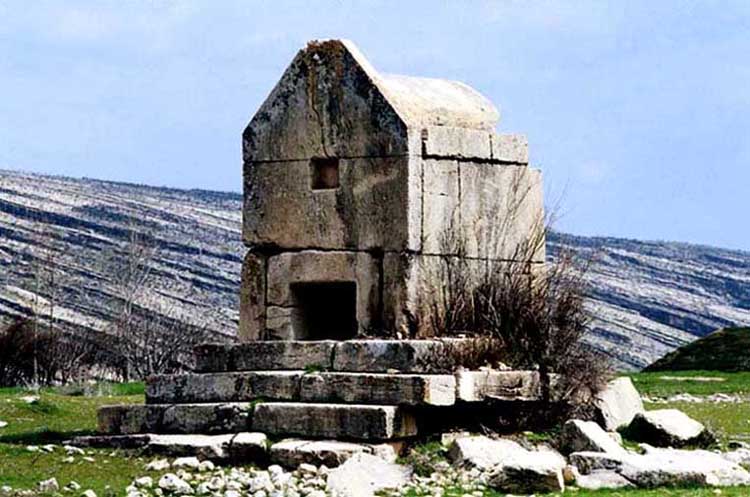Gur-e-Dokhtar , Near Barazjan, in Bushehr province, there is a historical building that is very similar to the famous tomb of Cyrus the Great. Of course, its understated elegance shows itself at the first glance; Stones with simple and primitive cuts and carvings. This historical building, which is located in the remote solitude of the plain, houses a person from the Achaemenid era. Although there is no definite information about the identity of the buried person; This building is considered to belong to a royal person. Gur-e-Dokhtar is one of the must-see places in Bushehr and is located in Jalga Barpez. This historical monument, although with a much more primitive architecture, is very similar to the tomb of Cyrus the Great. Therefore, most archaeologists consider it to be a remnant of the Achaemenid period.
Ali Akbar Sarfraz investigated and identified the Gur-e-Dokhtar and Bezpar Jalga and considers the Dokhtar tomb to belong to the early Achaemenid kings and Cyrus I, the son of Chishpesh, and the tomb above it belongs to his Elamite wife, the mother of Cyrus the Great, Shah of Iran. Of course, this is only one of several different opinions about the person buried in this cemetery.
The Gur-e-Dokhtar is rectangular in shape with a total height of 4.45 meters, with a gabled roof on it, and large cream-colored stone slabs have been used in its construction. This building is built on a stone mastaba, which was the primary infrastructure and platform for this building. Its main foundation includes shafts and river sands, on which the Mastaba and the main foundation were built. On the Mastaba, there are three rows of stones that lead to the main chamber. The lowest ridge on the ground is 5.10 meters long and 4.40 meters wide.
The height of the stones, which are stacked on top of each other, is 34 cm. The upper chamber on the stairs is 3.40 meters high, 2.95 meters long and 2.30 meters wide. The thickness of the stone walls of the building is about 75 cm. Inside, the tomb room is 2.20 meters long and 1.55 meters wide, and its height from the floor to the flat ceiling is 2.50 meters.
The Gur-e-Dokhtar is completely made of 22 pieces of stone, which do not show any elegance and they cut and sculpted the stones in a very basic way. All the stones of the tomb chamber are connected to each other by means of built-in metal fasteners, by means of dovetailed fasteners. In the construction of this building, like other structures built by Achaemenid architects, no mortar was used.
On the top of the tomb, there is a recessed part similar to a frame, which was probably the location of the related inscription. There is a small pond inside the building chamber.
The building has an entrance door with dimensions of 70 x 90 cm. There are no signs related to the lock and fastening of the door stone, and it is likely that there was no door stone at all, and if there was, they created a dry fold without any door heel or lock and fastening. On top of the entrance door and close to the ceiling, there is a 25 x 25 cm square niche-like space that is closed from the back.
Gur-e-Dokhtar was first discovered by the Belgian archaeologist, Louis Vandenberg, in 1339 AH. Vandenberg believed that the grave girl in the grave of Chishpish or Cyrus I (the ancestor of Cyrus the Great) is; But then Alireza Shapur Shahbazi considered it to be the tomb of Cyrus the Younger. There are many speculations about this building. The tomb of Mandana, the mother of Cyrus or Atusa, the daughter of Cyrus and the Achaemenid queen or sister of Cyrus are some other speculations about this building.
Most researchers believe that this building belongs to the Achaemenid period; However, different theories have been presented about this issue, depending on which period of the Achaemenid era and which king or prince it was.
From the time of Darius the Great onwards, during the Achaemenid period, the burial method was almost the same. In this way, all the graves in the body of the mountain were created in the form of crypts, and these crypts had graves in which the corpse was placed. Of course, this method was sometimes different, like the tomb of Darius and other tomb kings.
The tomb of Cyrus the Great in Pasargad is a tomb separate from the tombs of the kings after him, and it is different from other tombs with its architectural style and religious pattern. This tomb is very similar to the Gur-e-Dokhtar and this shows that both people have the same religion and are very close to each other in terms of belief.
Tomb of Cyrus the Great From these evidences, it seems that the tomb of Gur-e-Dokhtar must have been built before the tomb of Cyrus the Great. If this work was built after the tomb of Cyrus, it would undoubtedly have a better architectural structure than the tomb of Cyrus, not so primitive and simple




